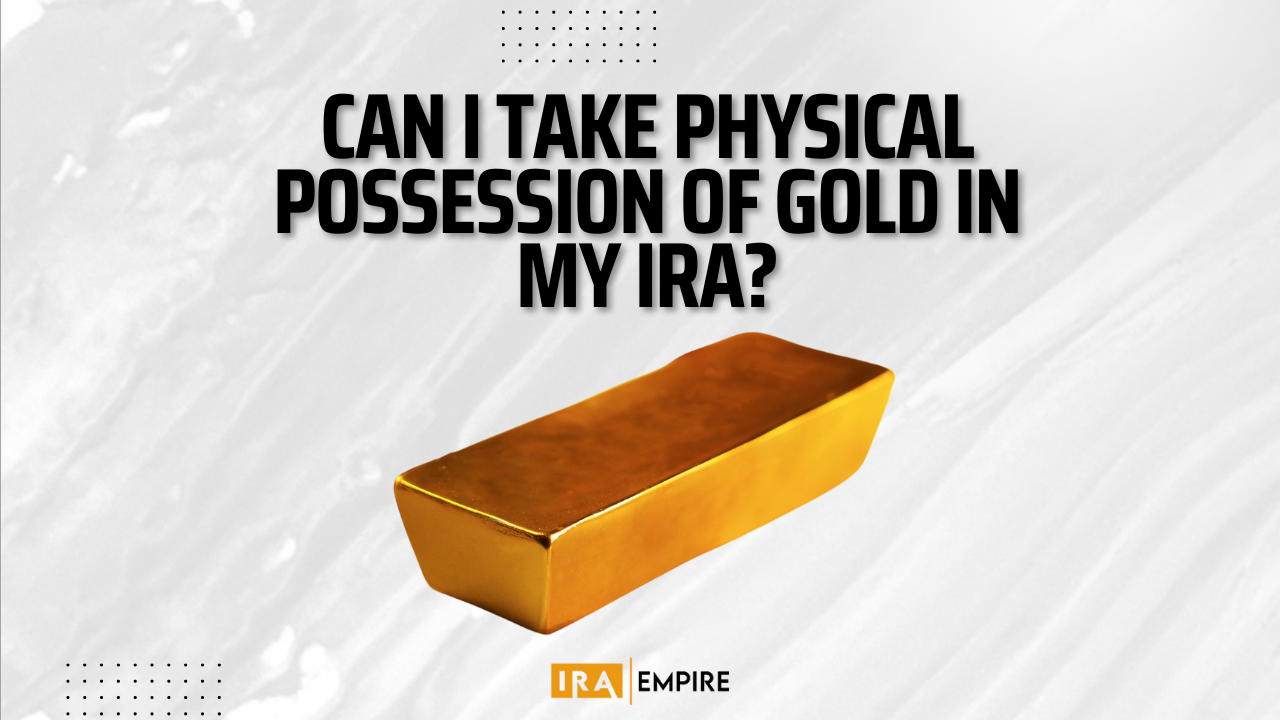Can I Take Physical Possession Of Gold In My Ira

Imagine the weight of gold in your hand, a tangible symbol of wealth and security. Sunlight glints off its smooth surface, a silent promise of stability in an uncertain world. The desire to hold your investments, to feel the security of physical assets, is a natural human instinct.
But can you truly take physical possession of the gold held within your Individual Retirement Account (IRA)? This article dives deep into the complexities of owning physical gold in an IRA and whether direct possession is a viable option.
The Allure of Gold in Retirement
Gold has been a store of value for millennia. Investors often turn to it as a hedge against inflation, economic downturns, and geopolitical instability. It's seen as a safe haven asset, a reliable alternative when traditional investments like stocks and bonds become volatile.
The appeal of holding physical gold – bars, coins, or bullion – is undeniable. It offers a sense of control and independence that paper assets simply can't replicate.
Why an IRA?
IRAs are tax-advantaged retirement accounts designed to help individuals save for their future. Contributions may be tax-deductible, and earnings grow tax-deferred, allowing your retirement savings to potentially grow faster over time.
Combining the perceived safety of gold with the tax benefits of an IRA seems like a winning strategy for many. But the IRS has specific rules about what types of assets can be held within an IRA, and how they must be managed.
The Strict Rules: No Direct Possession
The short answer to the question of taking physical possession of gold held in an IRA is no. The IRS does not allow you to directly hold the gold yourself. This is a key rule to understand.
According to IRS Publication 590-A, "Your IRA must be maintained by a U.S. bank or thrift institution, a U.S. insurance company, or other person authorized by the Treasury Department to act as trustee or custodian." This means your gold IRA must be managed by a qualified custodian.
The rationale behind this rule is to prevent commingling of IRA assets with personal assets. Allowing direct possession would make it difficult to track and verify compliance with IRA regulations, potentially leading to tax avoidance or other abuses.
The "Self-Directed" IRA Misconception
The term "self-directed IRA" can be misleading. While you have more control over the investment choices within a self-directed IRA, including the option to invest in gold, you still cannot take personal possession of the assets.
A self-directed IRA simply allows you to invest in assets beyond the typical stocks, bonds, and mutual funds offered by traditional brokerage firms. It's the custodian's responsibility to hold and manage the gold on your behalf.
What Happens if You Violate the Rule?
If you were to take physical possession of the gold held within your IRA, the IRS would consider it a distribution. This would trigger several negative consequences.
First, the value of the gold would be treated as taxable income in the year you took possession. Second, if you are under age 59 ½, you may be subject to a 10% early withdrawal penalty. Third, the entire IRA would be disqualified, meaning you would lose the tax-deferred status of all the assets within the account.
The Proper Way to Invest in Gold Through an IRA
While you can't physically hold the gold, you can still include it in your retirement portfolio through a properly structured gold IRA. Here's how it works:
- Establish a Self-Directed IRA: Choose a custodian that specializes in precious metals IRAs. These custodians are familiar with the IRS regulations and can help you navigate the process.
- Fund the IRA: You can fund the IRA with cash, or you can roll over or transfer funds from an existing retirement account, such as a 401(k) or traditional IRA.
- Purchase Gold: Work with the custodian to purchase IRS-approved gold bullion or coins. The gold must meet specific purity standards and be held in an approved depository.
- Storage: The gold is stored in a secure, insured depository. The custodian is responsible for ensuring the gold remains in compliance with IRS regulations.
IRS-Approved Gold
Not all gold is eligible for inclusion in an IRA. The IRS has specific requirements for the type and purity of gold that can be held within a retirement account.
Generally, gold bullion must be at least .995 fine (99.5% pure). Gold coins, such as American Eagle coins, are also allowed. However, collectible or numismatic coins are typically not permitted.
Choosing a Custodian and Depository
Selecting the right custodian and depository is crucial. Research their fees, reputation, and security measures. Ensure they are properly licensed and insured.
According to the Better Business Bureau, it’s important to check for any complaints filed against the custodian before entrusting them with your retirement savings.
Alternatives to Physical Gold in an IRA
If you're uncomfortable with the idea of not having direct access to your gold, consider alternative ways to invest in gold through your IRA that don't involve physical possession.
- Gold ETFs (Exchange-Traded Funds): These funds track the price of gold and offer a convenient way to gain exposure to the gold market. However, you don't own the physical gold itself.
- Gold Mining Stocks: Investing in companies that mine gold can provide leverage to the price of gold. However, the value of these stocks is also influenced by factors specific to the company and the overall stock market.
The Importance of Professional Advice
Investing in gold, whether through an IRA or otherwise, involves risks. It's essential to consult with a qualified financial advisor who can help you assess your risk tolerance, investment goals, and financial situation.
A financial advisor can provide personalized guidance and help you make informed decisions about whether gold is the right investment for you. They can also help you navigate the complexities of gold IRAs and ensure you comply with all IRS regulations.
The Peace of Mind of Compliance
While the allure of physically holding your gold is understandable, it's crucial to remember that doing so within an IRA context can have serious consequences. Following the IRS rules and working with a qualified custodian is the best way to enjoy the potential benefits of gold in your retirement portfolio while maintaining the tax advantages of your IRA.
The true security comes not from holding the gold in your hand, but from knowing that your investments are managed responsibly and in accordance with the law.
Ultimately, investing in gold within an IRA requires careful planning and adherence to strict rules. By understanding these regulations and working with qualified professionals, you can potentially add a valuable asset to your retirement portfolio while staying on the right side of the IRS.

















